William Ury described one way that The Third Side approach can help people to resolve differences. You can discover more about his superb work in this area via the following link.
The piece below explores another way of using the Third Side. It is an approach that has proved successful in helping people to work towards common goals. As negotiators sometimes say:
“The key is to start by focusing on the areas of agreement, because this sets the tone and builds confidence. You can also aim to get some quick successes.
“People will then feel more able to move on to the areas of disagreement and find solutions. It you start with the areas of disagreement, you are less likely to achieve success.”
Imagine the scene. Two parties are arguing about an issue. They each believe they are right and the other is wrong.
This script is repeated by divorcing couples, departments fighting each other and nations going to war.
People can get into difficulties because they ‘sit opposite each other’ and fight for their own agendas.
Each party says the equivalent of: “I am right,” or “Our side is right.” “You are wrong.” These are the First and Second Sides.
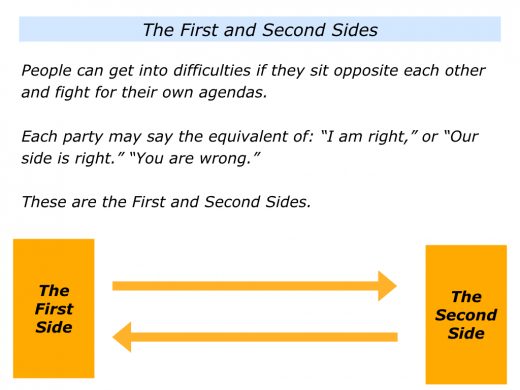
People are more likely to solve things if they can sit ‘side by side’ and look together towards a Third Side. This Third Side can be the greater goal, the mission, the company’s picture of success or whatever.
This is the greater ‘What’ and ‘Why’. People often get into arguments about the ‘How’, but it is important to focus on the higher purpose.
This purpose may be, for example, the children’s welfare after a divorce, the team’s mission, the company’s goals or the kind of world we want to pass on to future generations.
If you are a facilitator, you can sit side by side with the interested parties and encourage them to look together at a compelling Third Side. (We will look at how to do this later in the article.)
Providing you are clear on the agreed overall goals, you can then say things like:
“These are the goals to achieve. This is the picture of success. These are the benefits of achieving the goals.
“Is this something you want to work towards achieving?
“If so, how can you do your best to contribute to achieving the goals? How can you help other people to achieve the goals?”
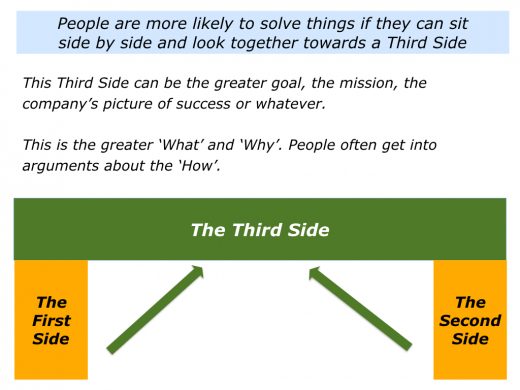
“That sounds simple in theory,” somebody may say. “But how does it work in practice?”
Let’s explore this approach. Before doing so, however, it is vital to understand that most conflicts only get solved when the following conditions are in place.
People must want to solve the conflict.
People must be prepared to work hard to find – as far as possible – win-wins.
Timing is everything. Many conflicts only get resolved when the parties are exhausted. Couples feel weary from fighting a divorce, terrorists became too old or too tired to fight, employers and strikers are exhausted after an industrial dispute.
People get tired of the negative energy. They are then more willing to sit down and find positive solutions. Before getting involved in any conflict resolution, it is important to ask the following questions.
Are people ready to work together?
Do they really want to solve the problem? Remember, some people are addicted to conflict.
Are people prepared to co-operate to find
– as far as possible – a win-win solution?
How high is their motivation to do this on a scale 0 – 10? People need to score at least a 7+ to have a chance of producing success.
Are people ready to focus on how
things can be better in the future?
This is crucial. Some people want to simply argue about the past and allocate blame. Whilst it may be vital to admit mistakes, the key is to focus on how to create a positive future.
Let’s assume that you believe it is likely that these conditions can be met. Or, at least, you can help to bring these about. If so, it can be useful to go through the following steps.
Clarifying
The Third Side
Imagine that you have been asked to facilitate a discussion about enabling people to work together towards a common goal. The first step is to clarify the potential Third Side.
This is what I was asked to do when invited to work with two department heads in a company. The Chief Executive was losing patience with the two teams that were supposed to work together to achieve the company’s goals.
But each team focused only on their own targets. When asked about cross-functional work, they blamed each other for failures.
This downward spiral affected the service given to customers and the whole company performance.
Bearing this in mind, I met the Chief Executive to clarify the real results to achieve. He was crystal clear on what he wanted them to contribute towards achieving the company’s picture of success.
This called for the respective departments to implement certain strategies to work together, deliver high levels of customer satisfaction and, in the process, contribute to achieving the company’s goals.
The key would be to encourage the department heads to focus on these outcomes. They had forgotten to focus on the real ‘What’ – the things they must deliver to achieve the company’s picture of success. Instead they had fallen into arguments about the ‘How’.
“This sounds relatively straight-forward,” somebody may say.
“But what happens when you don’t have an authority who can communicate the Third Side?”
Good facilitators then involve the key parties in clarifying the picture of success. Sometimes this calls for asking questions that uncover the real results to achieve.
How to make this happen? One approach is to invite people to look into the future. It is then to ask:
“What do you want people to be saying about how you behaved and what you did in this situation?
“What are the actual words you would like to hear each of the stakeholders – children, colleagues, customers, future generations, etc. – saying?”
This is an approach that can be used with couples, educators, leaders and people who care for future generations.
Building on the answers given, it is then possible to create an agreed picture of success. This becomes the Third Side.
If you wish, try tackling the exercise on this theme. Looking at your life and work, think of a situation where it might be useful to create a potential Third Side.
This could be in your professional life where you want to help people to work well together.
Alternatively, it might be in your personal life. For example, where you want to take the heat out of the situation, sit alongside somebody and work to achieve an agreed goal.
Describe a personal or professional situation where you think it might be useful to clarify a potential Third Side.
Describe the specific things you can do to clarify such a Third Side.
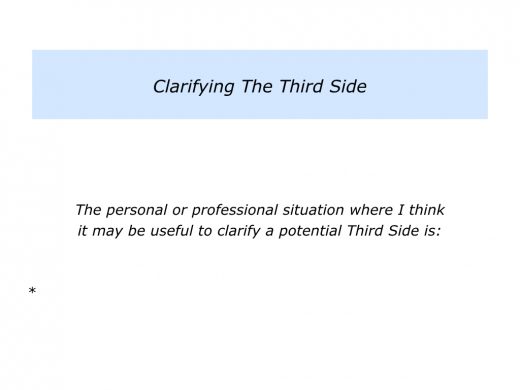
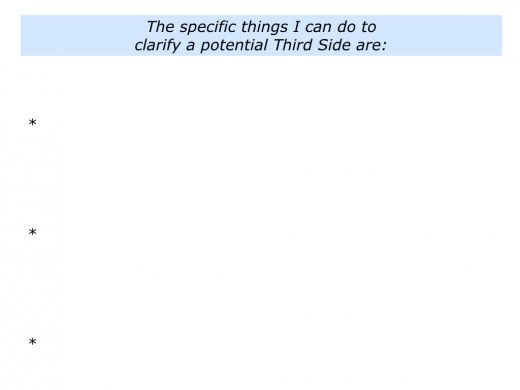
Communicating And
Committing To The Third Side
Imagine that you have been asked to facilitate a discussion around enabling people to work together towards a common goal.
The second step is to, where appropriate, make sure everybody understands the Third Side. It is then to check if people are committed to achieving this picture of success.
Looking at the example with the two departmental heads, the Chief Executive asked them to meet with me.
He explained the purpose of the meeting was to focus on how to pool their talents to achieve the company’s goal. He asked for their complete backing in the session and afterwards.
Both leaders had worked with me before, so they knew the session would be positive. During the meeting it was important to go through the following stages.
To create an encouraging environment and explain it was recognised that they were working flat out.
To explain that, if they were open to it, we would explore how they could be supported to combine their talents to achieve the company’s goals.
To put these goals in front of us so that we were literally all on the same side and looking together at the company’s picture of success.
Going deeper, I explained we had been tasked with working together to find solutions. Were they willing to work towards satisfying the customers and achieving the company’s goals?
“Yes, of course we are willing,” was the joint reply, followed by a few caveats.
The key, however, was to focus on this Third Side. Were they willing to work together to achieve the goals? Later we could explore solutions regarding how to deliver this picture of success.
Good facilitators create an encouraging environment. When appropriate, however, they also outline the specific results that they and the parties are expected to deliver.
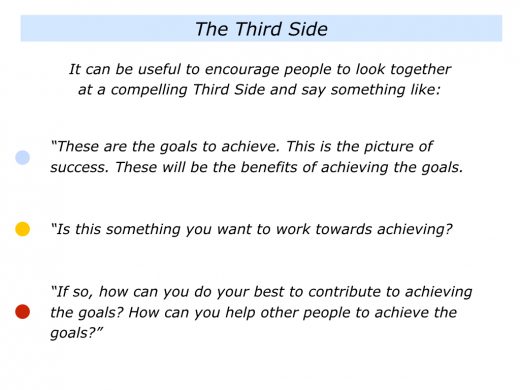
“I can see how that works when the decision has been made from above,” somebody might say. “But how to gain commitment when people must themselves create the Third Side?”
The clue is in their sense of ownership. In the past I have used elements of Appreciative Inquiry to enable people to describe their ‘Dream’. Here is an introduction to that approach.
People are again invited to describe the specific things they want to hear people saying in the future. Looking at their picture of success, they are asked:
To describe the pluses of achieving the goals.
To describe the potential minuses.
To describe how they can build on the pluses and minimise the minuses.
People are invited to rate their motivation to achieve the goal. They do this on a scale 0 – 10.
Where appropriate, they are asked to describe the specific things that could be done to improve the rating. Finally, they are asked if they want to commit to achieving the goal.
If you wish, try tackling the exercise on this theme. This invites you to do the following things.
Describe the personal or professional situation where you can do your best to communicate and ensure people are committed to achieving the Third Side.
Describe the specific things you can do to do your best to communicate and ensure people are committed to achieving the Third Side.
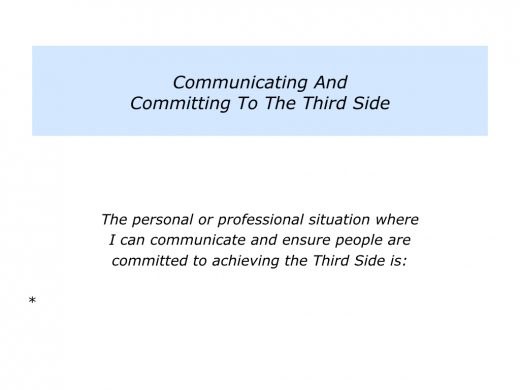
Concrete Steps Towards
Achieving The Third Side
The next stage is to encourage people to take concrete steps towards achieving the Third Side.
Success builds confidence. So it is vital for focus on specific things that people can do to deliver some early wins.
This is what happened with the two department heads in the company. They made specific action plans that involved them co-operating:
To deliver superb service to the customer.
To produce success stories that enhanced the reputation of the customer and company.
To proactively keep the Chief Executive informed about their ongoing contribution towards achieving the company’s picture of success.
Imagine that you are facilitating a discussion around enabling people to work together towards a Third Side.
You may be working with a couple that wants to help their children, an organisation that wants to shape a better future, a team that wants to solve a conflict or some other group.
How can you encourage them to get some early successes? If you wish, try tackling the exercise on this theme. This invites you to do the following things
Describe the personal or professional situation where you can encourage people to take steps towards achieving the Third Side.
Describe the specific things you can do to encourage people to take steps towards achieving the Third Side.
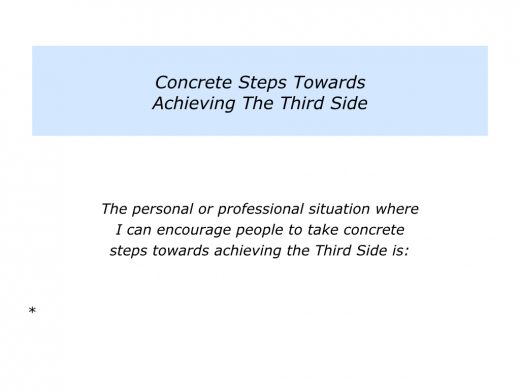
There are many approaches to helping people to tackle challenges. One approach is to invite them to go beyond sitting opposite each other and becoming locked in the First and Second Sides.
It is to invite them to sit alongside each other and work together to achieve a potential Third Side.


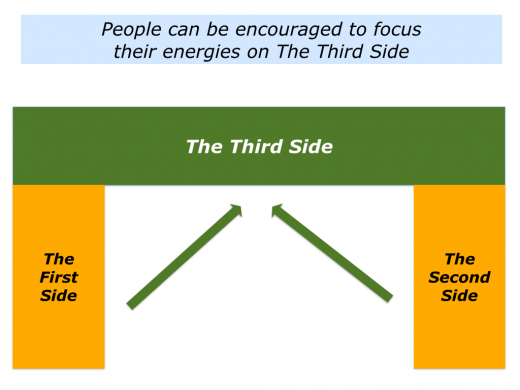
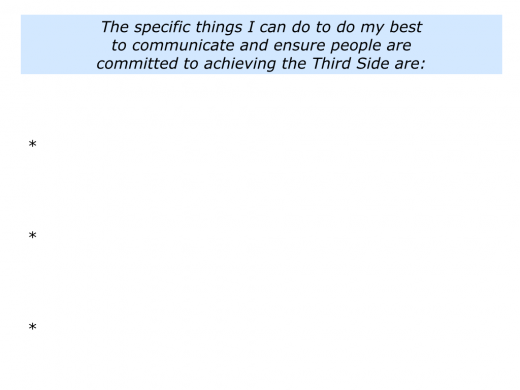
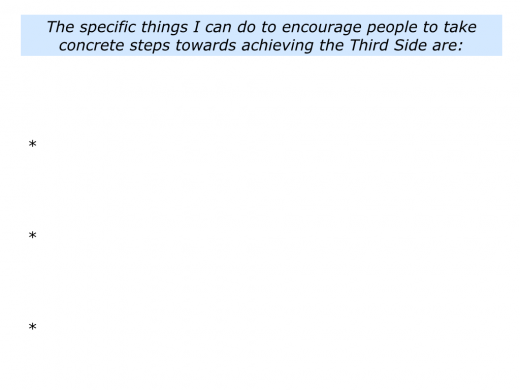
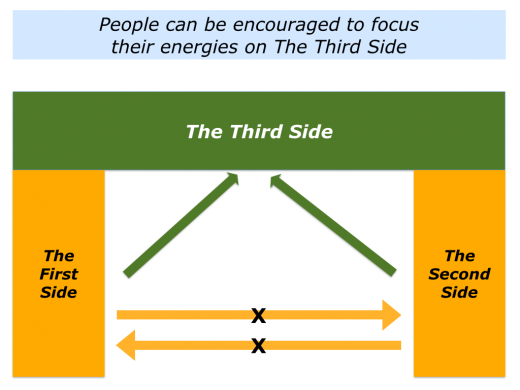




Where there are “conflict of interests” and dishonesty, in my experience, this has not happened.
It becomes impossible to have a 3rd side. Control is the way. Communication is used and manipulated. There is no ‘facilitator’ or 3rd party.
Old patterns and/or mindsets are part of the problem and an uneven playing field.
As Eldridge Cleaver said, “You’re either part of the solution or you’re part of the problem.”